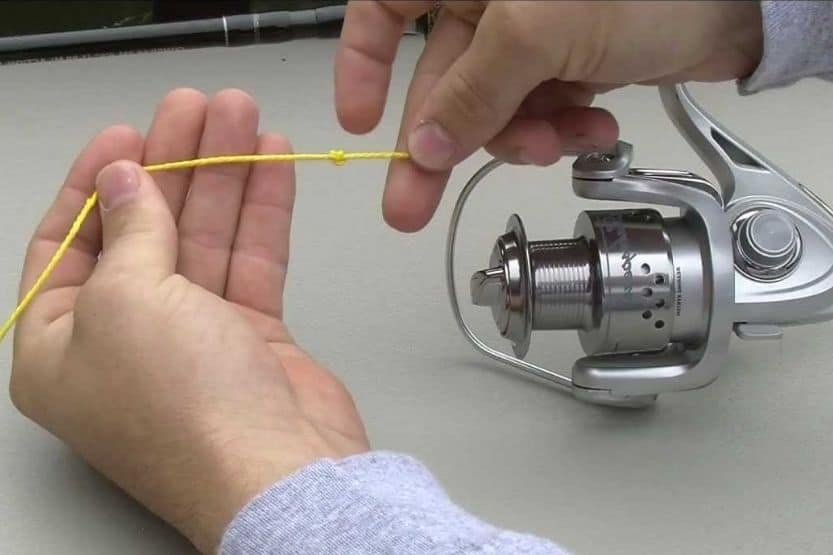To make the most of your fishing outings, you need the right equipment. One of the best tools you can have with you is an open face reel. What is an open face reel?
An open face reel is a type of fishing reel where the spool is not enclosed. It has a spool for line storage that is stationary. It makes the line stop uncoiling when the cast is completed and prevents backlash from happening. Open face reels are also called spinning reels.
Read on to learn more about open face reels, how to use them, and some helpful tips on using open face reels.
Open Face Reel

The open face reel has other characteristics. An open face reel has a handle that locks to keep the line from falling off the spool and spinning backward. Open face reels also usually come with a wire bail, which can be used for distance casting.
The open face reel is often chosen by intermediate and veteran anglers because their fingers have learned to guide the line as they cast. This requires a bit of practice to get right. However, this should not stop beginners from using open face reels.
How to Use an Open Face Reel
As we earlier mentioned, the open face fishing reel is a popular choice among anglers. Here, we discuss how to use an open face reel, step by step, starting with setting up your fishing rod.
1. Check and Gather All Your Equipment
You’ll need the following equipment:
- Spinning Reel: Before selecting a spinning reel, you should study your options and choose one that fits your needs. It will vary according to weight, size, and drag system. Spinning reels are either made from graphite or aluminum. While graphite is lighter, aluminum is stronger and gives more flex. Research the best spinning reel for you.
- Spinning Rod: The spinning rod usually is made to fit certain reels. Make sure your rod is compatible with your spinning reel.
- Fishing Line: How to put a fishing line on an open face reel? The fishing line will vary according to the type of fish you are catching. They will vary in material, length, and thickness.
- Bait or Hook: The bait will also depend on what you are fishing for. If you’re trying to catch various fish, bring different kinds of bait when you go fishing.
2. Know Your Equipment
For fishing, your two main pieces of equipment are the reel and the rod – the open face rod and reel combo. Each of these will have different parts. It’s important to know what these are.
The reel will have the following parts:
- Spool: The spool basically holds the fishing line as it is the part where the line is wound.
- Handle: The handle forces the reel back into place when it is turned.
- Bail: The bail stops the line from coming out of the spool. It is made from metal and can be closed and opened to control the line.
- Reel Foot: The reel foot basically is the connection between the reel and the rod.
- Drag Knob: The drag knob controls how easily the line comes out of the stool. You can adjust this by loosening or tightening it.
- Line Roller: The line roller will guide the line from the spool to the rod.
The rod has the following parts:
- Rod Tip: The rod tip comprises the last 4 inches of the rod. It is the thinnest part of the rod and can break easily if not handled properly.
- Guides: The guides are the tiny circles where the line goes thru and basically serve as a guide to keeping the line close to the rod.
- Reel Seat: The reel seat connects and secures the reel to the rod.
- Handle: The handle is the part that you hold when you are fishing. It is made up of soft material to make your grasp comfortable.
3. Connect the Reel to the Rod
To connect the reel to the rod, first, you’ll need to loosen the reel seat. Next, put the reel foot in the reel seat and then tighten the reel seat. Make sure that the reel is securely fastened without wobbling.
4. Spool the Reel
Spooling the reel must be done properly to avoid fishing difficulties. To do this, you need to start with opening the ball. Place the line once around the reel and tie a standard knot. A standard knot is also called an overhand knot.
You’ll then need to tie another knot with the ensuing line pieces. Cut the piece of line that hangs loosely away from the reel. Properly close the bail. Turn your reel until you have the number of lines that you need on the reel.
Pooling or putting line on the reel is a vital step to fishing and can lead to difficulties and frustration when fishing – if done improperly.
5. String the Rod
To string the rod, hold the line tip with one hand and, with the other, open the bail arm. Run the line through the rod guides.
6. Tie the Knot
Run the line through the eye of the hook. You’ll now have a piece of the line on one side of the hook. Hold one piece of line in each hand and cross one piece over the other. Now hold both pieces in one hand, having a loop on your pointer.
A dangling piece should be visible. Insert this through the loop, pull-on each end of the line to tighten the knot. Repeat this process of knotting 3 times so that you’re certain it won’t come undone.
7. Adjust the Drag Knob
The drag knob controls your line’s tension, which helps you “fight” your catch while reeling it in. It can be adjusted by turning it to tighten (clockwise) and loosen (counterclockwise). Test the line by pulling from your reel to see if you got the tension you desire. When the drag is too loose, it may allow the fish to get free from the hook. When the drag is too tight, the line can break.
8. Cast
How to cast an open face reel? You’ll need to let some line hang from the tip – maybe 1 ½ foot of line. With your casting hand, hold your rod with two fingers on either side of the reel foot. Place your line roller into a position under the rod.
Hold the line with your index finger against the rod. Open the bail with your other hand. Check behind you to make sure that all is clear. Bring your rod to a 2 o’clock position. Check that the line is straight and not tangled upon any part. Bring the rod forward smoothly and swiftly in the area you want to cast.
9. Reel in Your Line
There are various ways of reeling in a line. You can do it either fast or slow. You can reel in by jerking the bait or at a constant speed. It depends on the situation. To do basic reeling, close the bail, put the line in the roller, and turn the handle of your reel.
Open Face Reel Advantages

Many anglers use open face fishing reels for their many advantages.
An open face reel is also called a spinning reel, where the spool is not enclosed. It has a spool for line storage that is stationary. You store line on the spool, and it stops uncoiling when the cast is completed. The open face reel is located at the bottom of the rod. Open face reels stop backlash from happening.
Versatility
One of the advantages of using an Open Face Reel is because it is very versatile. You can also use these reels with both artificial lures and live bait. They are best for light tackle and bait because open face reels require only to pull the line’s weight.
Compatible with Other Lines
They also are compatible with more kinds of lines. Open face reels are more solidly constructed than spin-cast reels. You can use them for fishing in the open ocean, ice fishing, and pan fishing.
Tips on How to Use an Open Face Reel and Rod
1. Ask an Expert for Advice
This tip may seem funny at first, but it’s true. The best advice always comes from the experienced. And, if you’re a beginner angler, it can be overwhelming to know what to do first. Research about open face reels and then get the opinion of someone who has been fishing for a long time.
2. Pick the Appropriate Reel Size

There are many different reel sizes. It’s important to pick the right size for the fishing that you are going to do. The size of a spinning reel may be anywhere from 1000 to 5000. If you want to catch small freshwater fish, it is best to use sizes 1000 to 3000. If you want to catch bigger prey, go for size 4000 to 5000.
3. Manually Close the Bail
Usually, the bail will auto-close by reeling. Manual closing, however, will prolong reel life and lessen the chance of getting tangled.
4. Get an Anti-Reverse Locking Handle
An anti-reverse locking handle will keep the reel from turning backward if your hand slips off. Not all reels will come with this. If you’re a newbie, look for a reel with this feature, as it will allow you to back reel so as not to let the fish drag.
5. Know the Drag Well
When you catch a fish, the drag will allow a line to be drawn from the spool. It will be able to do this while keeping the resistance that puts pressure on the line. Know your drag well and set it properly to give you a good fight with your catch. If you set up the drag too tight, the line may snap.
6. The Reel Goes Under the Rod
Remember, the reel goes under the rod when you’re using an open face reel. With bait cast reels, the reel is on top of the rod. If you’re making a switch from spin cast to open face reel, make sure the reel is under.
Conclusion: Open Face Fishing Reels
There are so many reels to choose from out there, and it can be not very clear, even for veteran anglers. Open face reels are a popular choice because it has many advantages.
An open face reel is also called a spinning reel. These reels have spools that are not enclosed. The spool for line storage is completely stationary. You store line on the spool, and it stops uncoiling when the cast is completed. The open face reel is located at the bottom of the rod. Open face reels stop backlash from happening.
What are you waiting for? Go out there and fish! Again, here are the tips for when you choose an open face reel and rod:
- Ask an Expert for Advice
- Pick the Appropriate Reel Size
- Manually Close the Bail
- Get an Anti-Reverse Locking Handle
- Know the Drag Well
- The Reel Goes Under the Rod
Related reading:
How to Restring a Fishing Reel [6 Easy Steps]
Sixgill Fishing Review [Including the Various Sixgill Fishing Reels]

![Read more about the article Knocker Rig for Fishing [Uses and How to Make One]](https://boatinggeeks.com/wp-content/uploads/2020/12/knocker-rig-fishing-300x200.jpg)

![Read more about the article Canoe Fishing [14 Tips and 11 Accessories]](https://boatinggeeks.com/wp-content/uploads/2020/12/canoe-fishing-300x200.jpg)